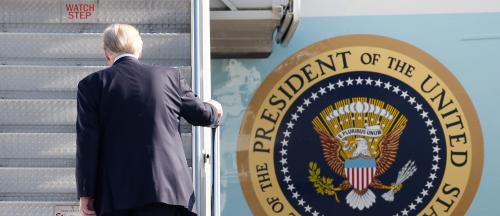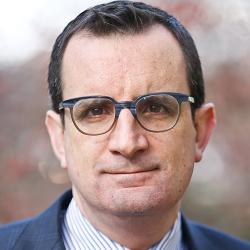Dodging a color revolution or large-scale political unrest is simple — Trump should not illegally interfere with the election count, argues Thomas Wright. If he gives such an order, his officials should not follow it. If they do, Republican members of Congress should oppose it and the courts should quickly intervene to stop him. This piece originally appeared in The Atlantic.
When a reporter recently asked Donald Trump if he would accept a peaceful transition of power, the president wouldn’t commit. “We’ll see what happens,” he said. In an apparent reference to mail-in ballots, he went on, “We’ll want to have—get rid of the ballots and you’ll have a very—we’ll have a very peaceful—there won’t be a transfer, frankly. There’ll be a continuation.” His comments seemed to confirm the worst fears of Democrats and anti-Trump Republicans who have warned for months that he might act illegally to hold on to power.
For Trumpian commentators, Democrats and the president’s other critics are only raising these concerns because they want to orchestrate a coup of their own. In a recent essay, “The Coming Coup?,” the former Trump-administration official Michael Anton warns his readers that Democrats are laying the groundwork for the “unlawful and illegitimate removal of President Trump from office.” Their tactic, he says, is to condition the public into thinking that Trump will try to steal the election so that if he wins, they can cry foul. They will then, Anton predicts, organize “a ‘color revolution,’ the exact same playbook the American deep state runs in other countries whose leadership they don’t like and is currently running in Belarus. Oust a leader—even an elected one—through agitation and call it ‘democracy.’” Anton advises Trump to prepare now to determine who will be loyal in the days after the election so that he can prevail.
Anton’s warning of a color revolution has gone viral on the Trumpian right. But his analysis rests on a fundamental misunderstanding of the concept. I’ve been looking at the history of color revolutions to see if conditions are actually ripe for one in the U.S.
The term color revolution was coined in the early aughts to describe four political revolutions in post-Communist Europe and Central Asia, in which repressive regimes tried to hold on to power after losing an election: in Serbia (the Bulldozer Revolution, named after a protester who used a bulldozer to storm the Parliament building), Georgia (the Rose Revolution, for the flowers that protesters held during demonstrations), Ukraine (Orange, the color identified with the opposition party), and Kyrgyzstan (Tulip, the national flower). Each case involved an election in which the regime committed fraud and was found out by a combination of impartial external election observers, exit polls, and a sophisticated voting-tabulation system. After the announcement of the fraudulent results, students led enormous popular protests, demanding either new elections or a ratification of the results.
The color revolutions deeply unnerved autocrats, particularly in Russia and China, who believed the West had orchestrated them. The uprisings came from within the countries, although Western nongovernmental organizations played a supporting role over time, particularly by shedding light on nondemocratic practices and helping the students organize. Alexander Cooley, the director of the Harriman Institute at Columbia University, who has studied color revolutions, told me that, contrary to conventional wisdom, the U.S. government was relatively detached and ambiguous about the protests in some of these cases. In Georgia, for example, it initially did not rush to back Mikheil Saakashvili over the incumbent, Eduard Shevardnadze; while in Kyrgyzstan, it worried about the implications for an American military base there.
By 2005, Moscow and Beijing were actively redefining the term, shifting from indigenous protests against fraudulent elections to exclusively mean externally imposed regime change. Over the next 10 years, color revolution was used to describe many mass protests against autocratic regimes: the Cedar Revolution in Lebanon in 2005, the Green Movement in Iran in 2009, the Arab Spring in 2010–12, the Snow Revolution in Russia in 2011–12, and more Orange protests in Ukraine in 2013–14. The Snow Revolution, pushing against Vladimir Putin’s rotation back into the presidency, exacerbated his paranoia about color revolutions.
While the protesters—students, NGOs, political opposition—learned tactics from one another, so too did the autocrats. Over the years, the leaders developed countermeasures. They denied visas to student leaders from abroad, set up their own pro-regime election monitors, banned NGOs that were advocating for democracy, and rigged elections by using intermediate measures, such as disqualifying candidates before election day.
The United States is not an autocracy, but Trump has embraced this paranoia. As Cooley noted, fears of unrest are borrowed from the Russian hymnbook: “Fear of the street protests, never spontaneous, never motivated by a sense of injustice, activists always paid, always a nefarious agenda—it is straight from the Kremlin’s talking points.” Accusing an opponent of what he is accusing you of—in this case, stealing the election—is a tactic Putin routinely uses to muddy the waters.
Other than this paranoia, are the conditions in place for an actual color revolution in the United States? In every respect except one extreme scenario—which, astonishingly, Trump has cultivated—the answer is no.
The 2016 election showed that foreign interference, even rising to the level of collusion with a foreign power, will not prevent the winner from being inaugurated, nor will it topple a president during his term. It may undermine the president’s legitimacy and the country’s confidence in the democratic process, but it won’t spark a color revolution. The 2000 contest proved that disputed elections can be resolved through the courts. Even if tensions are much greater now, it is extremely unlikely that the majority of Joe Biden’s voters will try to overturn a Supreme Court decision through direct action, even if Trump’s nominee to the court is in place. If Biden refuses to concede, which he has shown no signs of doing even though some Democrats have talked about it, his decision will not prevent Trump from being re-inaugurated if he is declared the winner. If the president refuses to leave the White House despite having lost, the legal and political system will take its course and power will transfer to Biden, albeit after an atrocious transition.
The original color revolutions occurred when the perception of clear and massive electoral fraud was widespread and protesters were angry about having democratic rights taken away. The demonstrations were directed at illegitimate regimes with a history of rigged elections, endemic corruption, and repression of political opponents. Trump is the most antidemocratic president in America’s history, but his administration so far does not meet the standard of the regimes affected by color revolutions. The U.S. still has an electoral process and a legal system.
However, one extreme scenario could push the United States toward a color revolution. If Trump actually tries to prevent large numbers of mail-in ballots from being counted by confiscating them, he could irreparably damage the electoral process and prevent the courts from being able to fairly adjudicate it. After all, what are the courts to do if the confiscated ballots have been destroyed or compromised (for instance, if the boxes were opened)? In this scenario, Trump would declare victory on Election Night if he is ahead in votes cast that day, and he would order Attorney General Bill Barr or Chad Wolf, the man Trump claims runs the Department of Homeland Security, to physically stop the count the next day. The president would then pressure Republican state legislatures to ratify his preferred result. This scenario is similar to what my Atlantic colleague Barton Gellman chillingly outlines in his new cover story.
Daniel Nexon, a political scientist at Georgetown University, told me that in the post-Communist unrest, independent election monitors from the Organization for Security and Cooperation in Europe played a crucial role in demonstrating fraud. External monitors have a more limited role in U.S. elections—they are present but in small numbers and few people pay attention to them. Trump, however, doesn’t control the polling stations. Shenanigans in particular districts could go under the radar for a while, but mass fraud—such as the federal confiscation of mail-in ballots—would likely occur in public view. Many Americans, perhaps millions of them, would feel that they had to take to the streets.
Protesters would want the U.S. to count every vote, as demonstrators did in earlier color revolutions, but that simply may not be possible if the ballots are confiscated and compromised. Nexon said that in most of the post-Communist cases, some mechanism existed for a revote, but U.S. law has no allowance for that. Therefore, if the worst case happens and Trump actively interferes in the count, the protests would likely focus on state legislatures and governors asked to ratify results before the count was complete, and on the Supreme Court, which may be asked to adjudicate.
Dodging a color revolution or large-scale political unrest is simple—Trump should not illegally interfere with the election count. If he gives such an order, his officials should not follow it. If they do, Republican members of Congress should oppose it and the courts should quickly intervene to stop him.
To prevent Anton’s theory from gaining further traction among Republicans, Democrats must be careful not to play into the Trumpist narrative that they are looking to delegitimize the president. They must stop suggesting that he can win only by cheating. As for citizens, we can vote early, preferably in person.
The U.S. election should be beyond reproach, but the political reality is making that unlikely. However, a Rubicon is in place that separates instability after the election from a color revolution. Ultimately, Trump and Trump alone will make the decision whether or not to cross it.










Commentary
Large-scale political unrest is unlikely, but not impossible
September 26, 2020